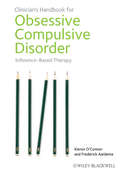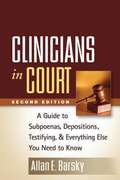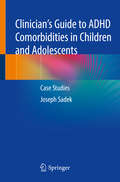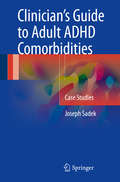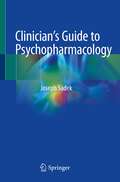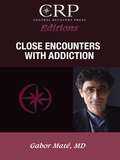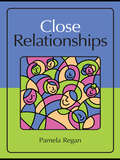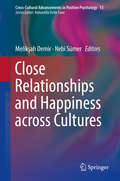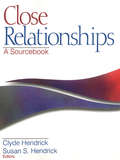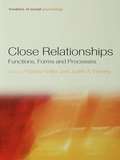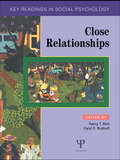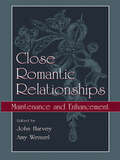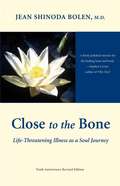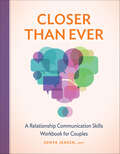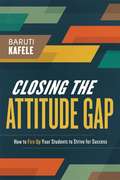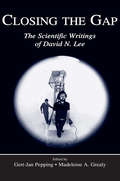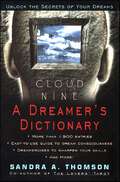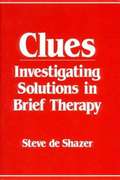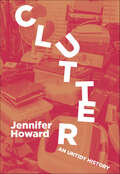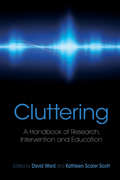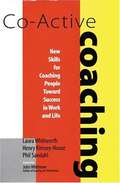- Table View
- List View
Clinician's Handbook for Obsessive Compulsive Disorder
by Frederick Aardema Kieron O'ConnorThis book is the first to bring together new research to offer a hands-on clinical guide to treating people with all types of obsessive compulsive disorder (OCD) using an inference-based therapy (IBT). Provides clinical examples from the full range of OCD subtypesCoverage integrates theory and applicationDecribes case management in detail - from initial assessment to terminating therapy and follow-upShows how IBT can also be generalized and applied to other serious psychiatric disorders
Clinicians in Court, Second Edition
by Allan E. BarskyInteracting with the legal system can be stressful and intimidating for mental health professionals. This trusted book provides user-friendly strategies to help clinicians prepare for testimony in court and other legal proceedings. Using vivid case scenarios from family law and other areas, the author explains legal terms and offers practical suggestions for avoiding pitfalls and managing ethical dilemmas. Clear guidelines are presented for record keeping, responding to subpoenas, preparing reports, and performing effectively on the stand as a fact witness or expert witness. Reproducible agreements and other sample documentation can be photocopied from the appendices or downloaded and printed in a convenient 8 1/2" x 11" size. New to This Edition Incorporates updates in research, case law, statutes, and practice. Examines the developing role of mental health professionals as forensic consultants. Increased attention to ethical issues, such as dual relationships, professional boundaries, confidentiality, and competence. An appendix with reflection questions that extend the scope of each chapter. Explores special issues that may arise in cases involving children Supplemental materials for course use-including an instructor's manual-are available at the author's website.
Clinician’s Guide to ADHD Comorbidities in Children and Adolescents: Case Studies
by Joseph SadekThe diagnosis and management of ADHD co-occurring with other disorders such as anxiety, depression, tics and substance use remain major challenges for clinicians treating all age groups. This book guides clinicians trough each step in the diagnosis and management of the comorbidity through essential case studies describing psychiatric disorders that frequently occur with child ADHD are well described in every case. Each case includes a diagnosis section and management section and is accompanied by questions and answers concerning the most important aspects in diagnosing and managing of both ADHD and the comorbid disorders. Drawn from actual clinical encounters, the case studies also feature ample current and valid references.
Clinician’s Guide to Adult ADHD Comorbidities: Case Studies
by Joseph SadekThe diagnosis and management of ADHD co-occurring with other disorders such as anxiety, depression and personality disorders remain major challenges for clinicians treating all age groups. This book guides clinicians through each step in the diagnosis and management of the comorbidities of adult ADHD on the basis of essential case studies describing psychiatric disorders that frequently occur with ADHD. Each case includes a diagnosis section and management section and is accompanied by questions and answers concerning the most important aspects in diagnosing and managing both ADHD and the comorbid disorders. Drawn from actual clinical encounters, the case studies also feature ample current and valid references.
Clinician’s Guide to Psychopharmacology
by Joseph SadekThis book employs a direct and clear approach to understanding the medications used in the treatment of psychiatric disorders. A range of areas, such as prescription errors, dosage modification in renal and hepatic dysfunction, augmentation strategies in treatment resistant patients, and recent findings from various clinical trials are addressed. Given its clear, straightforward approach, the book will be a valuable guide for all clinicians working with patients with psychiatric illness.
Close Encounters with Addiction
by Gabor MatéClose Encounters With Addiction is a lecture Dr. Gabor Maté gave in Los Angeles in April 2011. He talks about his experience as a physician and how many of his patients suffer from mental illness, drug addiction and HIV, or all three.
Close Relationships
by Pamela ReganThis multidisciplinary text introduces the concepts, methodologies, theories, and empirical findings of the field of interpersonal relationships. Information is drawn from psychology, communication, family studies, marriage and family therapy, social work, sociology, anthropology, the health sciences, and other disciplines. Numerous examples capture readers’ attention by demonstrating how the material is relevant to their lives. Active learning is encouraged throughout. Each chapter includes an outline to guide students, key terms and definitions to help identify critical concepts, and exploration exercises to promote active thinking. Many chapters include measurement instruments that students can take and score themselves. A website for instructors features a test bank with multiple-choice and essay questions and Power Points for each chapter. This text distinguishes itself with: Its focus on family and friend relationships as well as romantic relationships. Its multidisciplinary perspective highlighting the contributions to the field from a wide array of disciplines. Its review of the relationship experiences of a variety of people (of different age groups and cultures; heterosexual and homosexual) and relationship types (dating, cohabiting, marriage, friendships, family relationships). Its focus on methodology and research design with an emphasis on how to interpret empirical findings and engage in the research process. Cutting-edge research on "cyber-flirting" and online relationship formation; the biochemical basis of love; communication and social support; bullying and peer aggression; obsession and relational stalking; sexual violence (and marital rape); and grief and bereavement. The book opens by examining the fundamental principles of relationship science along with the research methods commonly used. The uniquely social nature of humans is then explored including the impact relationships have on health and well-being. Part 2 focuses on relationship development—from attraction to initiation to development and maintenance as well as the factors that guide mate choice and marriage. The development of relationships in both friendships and romantic partnerships is explored. Part 3 examines the processes that shape our interpersonal experiences, including cognitive (thinking) and affective (feeling) processes, communicative and supportive processes, and the dynamics of love and sex. The book concludes with relationship challenges—rejection and betrayal; aggression and violence; conflict and loss; and therapeutic interventions. Intended as a text for courses in interpersonal/close relationships taught in psychology, communication, sociology, anthropology, human development, family studies, marriage and family therapy, and social work, practitioners interested in the latest research on personal relationships will also appreciate this engaging overview of the field.
Close Relationships and Happiness across Cultures (Cross-Cultural Advancements in Positive Psychology #13)
by Melikşah Demir Nebi SümerThis volume focuses explicitly on close relationships as a reliable source for individual happiness and well-being across cultures. The work in this volume addresses theoretical issues and presents new cross-cultural data in the study of close relationships and happiness. Experts from different parts of the world provide in-depth, authoritative reviews and new findings on the relationship between various types of close bonds (e.g., intimate, marital, friendship, grandparent) and happiness in a variety of cultures. An ideal resource for researchers and students of relationship science and positive psychology, this rich, clear, and up-to-date book serves as an important reference for academicians in related fields of psychology such as cross-cultural, social, and developmental.
Close Relationships: A Sourcebook
by Clyde A. Hendrick Dr Susan S. HendrickAs Ellen Bercheid points out in her foreword to this volume, relationship science is a complex and ever expanding field. Much credit goes to editors Clyde Hendrick and Susan S. Hendrick for their scholarly dedication to the advancement of this multidisciplinary arena. This sourcebook demonstrates, yet again, their expertise and leadership as they succeed in combining many great contributions to the field by some of the most respected specialists around. Read this book for a panoramic view of close relationship research with highlights from current literature, original research, practical applications, and projections for future research.
Close Relationships: Functions, Forms and Processes (Frontiers of Social Psychology #14)
by Patricia Noller Judith A. FeeneyClose Relationships: Functions, Forms and Processes provides an overview of current theory and research in the area of close relationships, written by internationally renowned scholars whose work is at the cutting edge of research in the field. The volume consists of three sections: introductory issues, types of relationships, and relationship processes. In the first section, there is an exploration of the functions and benefits of close relationships, the diversity of methodologies used to study them, and the changing social context in which close relationships are embedded. A second section examines the various types of close relationships, including family bonds and friendships. The third section focuses on key relationship processes, including attachment, intimacy, sexuality, and conflict.This book is designed to be an essential resource for senior undergraduate and postgraduate students, researchers, and practitioners, and will be suitable as a resource in advanced courses dealing with the social psychology of close relationships.
Close Relationships: Key Readings (Key Readings in Social Psychology)
by Harry T. ReisEach of the chapters in this reader is written by leading scholars in the area of relationships, reflecting the diversity of the field and including both contemporary and key historical papers for comprehensive coverage of research.
Close Romantic Relationships: Maintenance and Enhancement
by Amy Wenzel John H. HarveyWith contributions from the leading experts on relationships, this book covers important issues, such as love as self-expansion, equity in maintaining close relationships, commitment, social support, self-verification, and minding the relationship. The end result is a comprehensive account of the reasons why close relationships are or are not maintained and the manner in which these principles can be applied to current social issues and clinical interventions. Divided into two sections, Part I describes models developed to characterize how relationships are maintained over time, accounts of specific mechanisms at work in close relationships, and conceptualizations of the maintenance and enhancement of close relationships using existing theoretical paradigms. Part II addresses contemporary social issues, as well as clinical applications. Close Romantic Relationships will appeal to students, researchers, and professionals due to its broad sampling of theory and research on relationship maintenance and enhancement.
Close to the Bone: Life-Threatening Illness as a Soul Journey
by Jean Shinoda BolenA guide for people whose lives are changed by a life-threatening illness. When you or a loved one is facing such a situation, this book helps deepen and connect people to what they know "in their bones."
Closer Than Ever: A Relationship Communication Skills Workbook for Couples
by Sonya JensenStrengthen your communication and build a brighter future together The differences between you and your partner can be the building blocks for growth in your relationship — you just need the right tools to guide you. This relationship communication workbook is filled with compassionate advice and exercises to help any couple interact productively, handle conflict, and deepen their connection. Understand the fundamentals— Grow closer with guidance for maintaining healthy communication and listening with an open mind. Practice your skills— Discover prompts and activities to help you and your partner increase self-awareness, become comfortable with vulnerability, and own your mistakes. Find inspiration from others— Learn from the stories of other couples who have improved their communication with these evidence-based techniques. For every couple —Find guidance and activities that are inclusive for couples of all backgrounds, lifestyles, and orientations. Create a deeper connection with your partner through this supportive couples therapy workbook .
Closing The Attitude Gap: How To Fire Up Your Students To Strive For Success
by Baruti KafeleIn this inspiring and thought-provoking follow-up to his 2009 best-seller Motivating Black Males to Achieve in School and in Life, Baruti Kafele makes the case that the "attitude gap" that often affects underperforming students can only be closed if educators first help students develop the will to strive for excellence. According to Kafele, educators can achieve remarkable results by focusing on five key areas: <p><p> * The teacher's attitude toward students <p> * The teacher's relationship with students <p> * The teacher's compassion for students <p> * The learning environment <p> * The cultural relevance of instruction <p> Replete with practical strategies and illustrative anecdotes drawn from the author's 20-plus years as a teacher and principal in inner-city schools, Closing the Attitude Gap offers a wealth of lessons and valuable insights that educators at all levels can use to fire up their students' passion to learn.
Closing the Gap: The Scientific Writings of David N. Lee
by Gert-Jan Pepping Madeleine A. GrealyThis book is a collection of Lee‘s most important works, placed in a historical setting and contextualized through the commentaries of other leading researchers in the field. The contributors were selected on the basis of their standing in the field. Some have been directly involved in collaborations with Lee, while others have participated in publ
Cloud Nine: A Dreamer's Dictionary
by Sandra A. ThomsonDreams -- windows into an inner world of hidden emotion and desire. Only by understanding our dreams can we fully know ourselves. And by recognizing the revealing subconscious meanings of our dreams and using that information in our waking lives, we have a greater opportunity for personal growth and change.Here is the most complete and comprehensive dream dictionary available. An essential resource for, exploring the subconscious mind, it offers thousands of dream symbols and definitions, listed alphabetically. For anyone who wishes to fully realize personal potential, this invaluable guide to dream interpretation provides essential information on how to:Keep a dream journalRecognize and understand your own personal dream symbology Encourage peaceful sloop and pleasant dreamsBring positive dreams to realityBanish bad dreams and gain Insight from nightmaresInvoke healing dreamsMonitor your personal progress by understanding your dreams a And much, much more!Including: Illuminating exercises, dreamwork techniques, pointers for improving visualization skills, and tips from some of the world's most respected contemporary dream masters.
Club Drugs and Novel Psychoactive Substances: The Clinician's Handbook
by Owen Bowden-Jones Dima AbdulrahimOver the last decade many hundreds of new psychoactive drugs have emerged onto illicit markets. This flood of new drugs has led to clinicians being unsure of the rapidly emerging changing evidence base and uncertain of the best approaches to assessment and clinical management. This book provides a concise, accessible summary of these emerging drugs. By categorizing the hundreds of new drugs by their predominant psychoactive effect - sedative, stimulant and hallucinogenic - the book helps clinicians to manage a drug they are unfamiliar with by using their experience of other drugs with similar psychoactive properties. Written for clinicians from across the frontline, from A&E staff to drug treatment professionals, the authors draw on numerous clinical examples from their own clinical experiences to illustrate aspects of assessment and management. Club drugs and novel psychoactive substances will continue to challenge clinicians and this handbook provides readers with an invaluable introduction to this complex area.
Clues: Investigating Solutions In Brief Therapy
by Steve De ShazerOnce therapist and client are focused on investigating solutions rather than problems, therapy inevitably becomes brief―sometimes only one session. Engaging cases, often with surprising twists, illustrate this practice-based theory of brief therapy with a wide range of complaints. Both theoretically stimulating and clinically sound, de Shazer's investigations turns up clues with the potential to revolutionize the way psychotherapy is thought about and practiced.
Cluster Analysis in Neuropsychological Research: Recent Applications
by Daniel N. Allen Gerald GoldsteinCluster analysis is a multivariate classification technique that allows for identification of homogenous subgroups within diverse samples based on shared characteristics. In recent years, cluster analysis has been increasingly applied to psychological and neuropsychological variables to address a number of empirical questions. This book provides an overview of cluster analysis, including statistical and methodological considerations in its application to neurobehavioral variables. First, an introduction to cluster analysis is presented that emphasizes issues of relevance to neuropsychological research, including controversies surrounding it use. Cluster analysis is then applied to clinical disorders that do not have an associated prototypical neuropsychological profile, including traumatic brain injury, schizophrenia, and health problems associated with homelessness. In a second application, cluster analysis is used to investigate the course of normal memory development. Finally, cluster analysis is applied to classification of brain injury severity in children and adolescents who sustained traumatic brain injury.
Clutter: An Untidy History
by Jennifer Howard&“A brilliant and beautiful meditation on the nature of our attachment to things. Reading Clutter made me long for a life without clutter.&” —Malcolm Gladwell, New York Times–bestselling author and host of the Revisionist History podcast &“I&’m sitting on the floor in my mother&’s house, surrounded by stuff.&” So begins Jennifer Howard&’s Clutter, an expansive assessment of our relationship to the things that share and shape our lives. Sparked by the painful two-year process of cleaning out her mother&’s house in the wake of a devastating physical and emotional collapse, Howard sets her own personal struggle with clutter against a meticulously researched history of just how the developed world came to drown in material goods. With sharp prose and an eye for telling detail, she connects the dots between the Industrial Revolution, the Sears & Roebuck catalog, and the Container Store, and shines unsparing light on clutter&’s darker connections to environmental devastation and hoarding disorder. In a confounding age when Amazon can deliver anything at the click of a mouse and decluttering guru Marie Kondo can become a reality TV star, Howard&’s bracing analysis has never been timelier. &“In her stern and wide-ranging new manifesto, Clutter: An Untidy History, journalist Jennifer Howard takes the anti-clutter message a step further. Howard argues that decluttering is not just a personally liberating ritual, but a moral imperative, a duty we owe both to our children and to the planet.&” —Jennifer Reese, The Washington Post &“Blending her personal experience and her research, Howard creates an engaging narrative that is colored by her investment in understanding hoarding in all of its complexities.&” —Linda Levitt, PopMatters
Cluttering: A Handbook of Research, Intervention and Education
by David Ward Kathleen Scaler ScottVery few people are aware of the significant negative impact that cluttering -- a communication disorder that affects a person's ability to speak in a clear, concise and fluent manner -- can have on one's life educationally, socially and vocationally. Although different from stuttering, it is often related to this more well-known disorder. This book treats cluttering as a serious communication disorder in its own right, providing an in-depth examination of the critical factors surrounding its assessment, treatment and research. Using evidence-based data as well as information regarding the assessment and treatment of cluttering within the field of speech-language pathology, the volume includes the latest research findings and work from leading cluttering experts, worldwide. Current viewpoints regarding cluttering, along with substantiated evidence are provided. Research findings are presented regarding the nature and neurology of cluttering. A range of assessment and treatment methodologies are described in the context of disorders that may co-occur with cluttering, such as autism spectrum disorders, learning disabilities, Down syndrome and stuttering. Future directions with regards to the definition, teaching and researching of cluttering are also addressed. Clinicians, faculty members, researchers, students in the field of speech pathology, and those who clutter, alike, will find this book an essential and unique source of information on cluttering.
Co-Active Coaching: New Skills for Coaching People Toward Success in Work and Life
by Laura Whitworth Henry Kimsey-House Phil SandahlThis book is the student training manual written by members of the Coach Training Institute.
Co-Constructing Therapeutic Conversations: A Consultation of Restraint (The Systemic Thinking and Practice Series)
by Ivan B. Inger Jeri IngerThis book illustrates the unique systemic approach of the Ingers who are well-known teachers and co-founders of the Family Studies Institute in Portland, Oregon. Their work combines elements of the reflective team approach with a model of co-therapy. It is a fresh and innovative application of systemic thinking to the field of family therapy. The book consists of a full-length description of one family consultation with detailed commentary on the process of the interview provided by the Ingers. The theoretical basis of their model is a carefully explained and the interview itself is discussed by a range of American and British therapists taking part in a family therapy exchange.
Co-Counselling: The Theory and Practice of Re-evaluation Counselling (Advancing Theory in Therapy)
by Caroline New Katie KauffmanThe theory behind Co-Counselling argues that emotional expression should be welcomed and that human beings can help each other recover from past distress by taking turns giving and receiving attention. Benefits of the method include the acceleration of personal growth and the reduction of the stresses inherent in the practitioner's role. This accessible book offers a serious challenge to much of what is currently considered good practice in mental health services, and succeeds in developing a dialogue between co-counselling and other therapeutic approaches. It provides a thorough introduction to the method, incorporating recent developments in the field and providing a comprehensive account of both the theory and practice. The reader also benefits from inclusion of clinical material outlining the experiences of people from a range of backgrounds offering evidence of the value of Co-Counselling. Co-Counselling offers a model that has many implications for anyone struggling with emotional problems, particularly those recovering from discrimination, prejudice and oppression. Counsellors and psychotherapists will find this book to be an invaluable resource which both challenges and stimulates.
